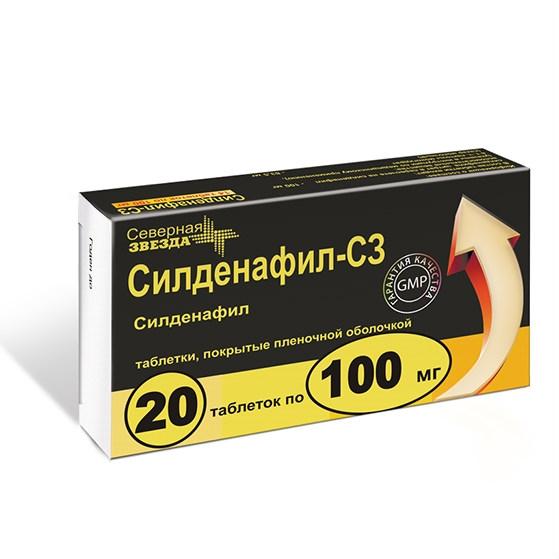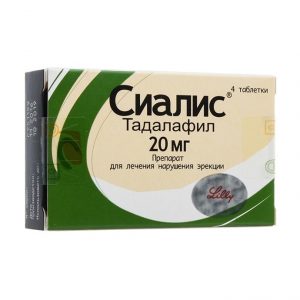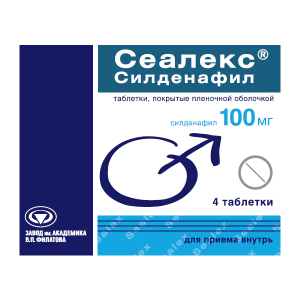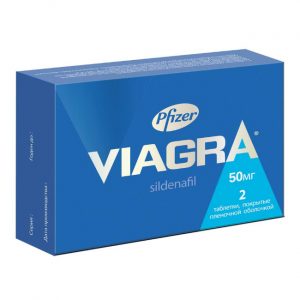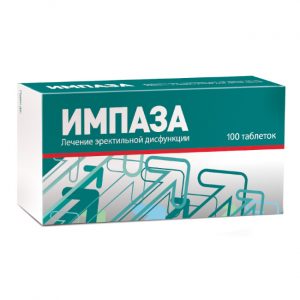Description
Packaging
20 pcs
Pharmacological action
Sildenafil is a potent selective inhibitor of cycloguanosine monophosphate (cGMP) type 5 phosphodiesterase (PDE5).
Mechanism of Action
The implementation of the physiological mechanism of erection is associated with the release of nitric oxide (NO) in the corpora cavernosa during sexual stimulation. This, in turn, leads to an increase in the level of cGMP, subsequent relaxation of the smooth muscle tissue of the corpora cavernosa and increased blood flow.
Sildenafil does not have a direct relaxing effect on an isolated human cavernous body, but enhances the effect of nitric oxide (NO) by inhibiting PDE5, which is responsible for the breakdown of cGMP.
Sildenafil is selective for PDE5 in vitro, its activity for PDE5 is superior to that of other known phosphodiesterase isoenzymes: PDE6 – 10 times PDE1 – more than 80 times PDE2, PDE4, PDE7-PDE11 – more than 700 times. Sildenafil is 4,000 times more selective for PDE5 compared to PDEZ, which is very important because PDEZ is one of the key enzymes for regulating myocardial contractility.
A prerequisite for the effectiveness of sildenafil is sexual stimulation.
Clinical data
Cardiological studies
The use of sildenafil in doses up to 100 mg did not lead to clinically significant ECG changes in healthy volunteers. The maximum decrease in systolic pressure in the supine position after taking sildenafil in a dose of 100 mg was 8.3 mm RT. Art., and diastolic pressure – 5.3 mm RT. Art. A more pronounced, but also transient effect on blood pressure was observed in patients taking nitrates.
In a study of the hemodynamic effect of sildenafil in a single dose of 100 mg in 14 patients with severe coronary artery disease (more than 70% of patients had stenosis of at least one coronary artery), systolic and diastolic resting pressure decreased by 7% and 6% , respectively, and pulmonary systolic pressure decreased by 9%. Sildenafil did not affect cardiac output and did not disrupt blood flow in stenosed coronary arteries, and also led to an increase (by about 13%) in adenosine-induced coronary flow in both stenosed and intact coronary arteries.
In a double-blind, placebo-controlled study, 144 patients with erectile dysfunction and stable angina pectoris taking antianginal drugs (except nitrates) performed physical exercises until the severity of symptoms of angina pectoris decreased. The duration of the exercise was significantly longer (19.9 seconds 0.9 – 38.9 seconds) in patients taking sildenafil in a single dose of 100 mg compared with patients receiving placebo.
In a randomized, double-blind, placebo-controlled study, the effect of changing the dose of sildenafil (up to 100 mg) in men (n = 568) with erectile dysfunction and hypertension taking more than two antihypertensive drugs was studied. Sildenafil improved erection in 71% of men compared to 18% in the placebo group. The frequency of adverse effects was comparable to that in other groups of patients, as well as in individuals taking more than three antihypertensive drugs.
Studies of visual impairment
In some patients, 1 hour after taking sildenafil at a dose of 100 mg, a mild and transient impairment in the ability to distinguish shades of color (blue / green) was detected using the Farnsworth-Munsel 100 test. 2 hours after taking the drug, these changes were absent. Believed that color vision impairment is caused by the inhibition of PDE6, which is involved in the process of light transmission in the retina. Sildenafil did not affect visual acuity, contrast perception, electro-retinogram, intraocular pressure or pupil diameter.
In a placebo-controlled crossover study of patients with proven early-stage macular degeneration (n = 9), a single dose of 100 mg sildenafil was well tolerated. There were no clinically significant changes in vision assessed by special visual tests (visual acuity, Amsler lattice, color perception, color transmission modeling, Humphrey perimeter and photo stress).
Efficacy
The efficacy and safety of sildenafil was evaluated in 21 randomized, double-blind, placebo-controlled studies lasting up to 6 months in 3000 patients aged 19 to 87, with erectile dysfunction of various etiologies (organic, psychogenic or mixed). The effectiveness of the drug was evaluated globally using an erection diary, an international index of erectile function (a validated questionnaire on the state of sexual function) and a survey of a partner.
The effectiveness of sildenafil, defined as the ability to achieve and maintain an erection sufficient for satisfactory intercourse, was demonstrated in all studies and was confirmed in long-term studies lasting 1 year. In fixed-dose studies, the ratio of patients reporting that therapy improved their erection was 62% (sildenafil dose 25 mg), 74% (sildenafil dose 50 mg) and 82% (sildenafil dose 100 mg) compared to 25% in the placebo group. The analysis of the international index of erectile function showed that in addition to improving erection, treatment with sildenafil also increased the quality of orgasm, and allowed achieving satisfaction from sexual intercourse and general satisfaction.
According to generalized data, among patients reporting improved erections during treatment with sildenafil were 59% of patients with diabetes, 43% of patients undergoing radical irostatectomy and 83% of patients with spinal cord injuries (versus 16%, 15% and 12% in the placebo group, respectively).
Pharmacokinetics
The pharmacokinetics of sildenafil in the recommended dose range is linear.
Absorption
After oral administration, sildenafil is rapidly absorbed. The absolute bioavailability is on average about 40% (from 25% to 63%). In vitro, sildenafil at a concentration of about 1.7 ng / ml (3.5 nM) inhibits the activity of human PDE5 by 50%. After a single dose of 100 mg sildenafil, the average Cmax of free sildenafil in male blood plasma is about 18 ng / ml (38 nM). Cmax when taking sildenafil inside an empty stomach is achieved on average within 60 minutes (from 30 minutes to 120 minutes). When taken in combination with fatty foods, the absorption rate decreases: Cmax decreases on average by 29%, and TCmax increases by 60 minutes, however, the degree of absorption does not significantly change (the area under the concentration-time pharmacokinetic curve (AUC) decreases by 11%).
Distribution
The volume of distribution of sildenafil in equilibrium is an average of 105 liters. The connection of sildenafil and its main circulating N-demethyl metabolite with plasma proteins is about 96% and does not depend on the total concentration of the drug. Less than 0.0002% of the dose of sildenafil (an average of 188 ng) was found in semen 90 minutes after taking the drug.
Metabolism
Sildenafil is metabolized mainly in the liver by the action of the cytochrome CYP3A4 isoenzyme (main pathway) and the cytochrome isoenzyme CYP2C9 (minor pathway). The main circulating active metabolite formed as a result of N-demethylation of sildenafil undergoes further metabolism. The selectivity of the action of this metabolite in relation to PDE is comparable to that of sildenafil, and its activity against PDE5 in vitro is about 50% of the activity of sildenafil. The plasma metabolite concentration of healthy volunteers was about 40% of the sildenafil concentration. The N-demethyl metabolite undergoes further metabolism. T1 / 2 is about 4 hours.
Excretion
The total clearance of sildenafil is 41 l / h, and the final T1 / 2 is 3-5 hours. After oral administration, as after intravenous administration, sildenafil is excreted as metabolites, mainly by the intestines (about 80% of the oral dose) and, to a lesser extent, by the kidneys (about 13% of the oral dose).
Pharmacokinetics in special patient groups
Elderly patients
In healthy elderly patients (over 65), the clearance of sildenafil is reduced, and the concentration of free sildenafil in blood plasma is approximately 40% higher than in young people (18-45 years old). Age does not have a clinically significant effect on the incidence of side effects.
Renal dysfunction
With mild (creatinine clearance (CC) 50-80 ml / min) and moderate (CC 30-49 ml / min) renal failure, the pharmacokinetics of sildenafil does not change after a single oral dose of 50 mg. In severe renal failure (CC <30 ml / min), the clearance of sildenafil decreases, which leads to an approximately twofold increase in the values of AUC (100%) and Cmax (88%) compared with those in normal renal function in patients of the same age group. Impaired liver function In patients with liver cirrhosis (stages A and B according to the Child-Pyo classification), the clearance of sildenafil is reduced, which leads to an increase in the values of AUC (84%) and Stax (47%) compared with those with normal liver function in patients of the same age group. The pharmacokinetics of sildenafil in patients with severe hepatic impairment (stage C according to the Child-Pyo classification) has not been studied. Indications Treatment of erectile dysfunction characterized by an inability to achieve or maintain an erection of the penis, sufficient for satisfactory sexual intercourse. Sildenafil is effective only with sexual stimulation. Use during pregnancy and lactation The drug is not intended for use in women. Composition of 1 tablet contains: Active ingredient: sildenafil (in the form of citrate) 100 mg Excipients: microcrystalline cellulose 83.5 mg, lactose monohydrate 83.5 mg sodium srdl ppm krd stearate 3 mg. Film composition: Opadray II (polyvinyl alcohol, partially hydrolyzed 3.6 mg, titanium dioxide 2.061 mg, macrogol 1.818 mg, talc 1.332 mg, brilliant blue aluminum varnish 0.1728 mg, iron oxide (II) yellow 0.0153 mg, iron oxide (Ii) black 0.0009 mg). Dosage and administration of sildenafil is taken orally. The recommended dose for most adult patients is 50 mg approximately 1 hour before sexual activity. Given the effectiveness and tolerability, the dose can be increased to 100 mg or reduced to 25 mg. The maximum recommended dose is 100 mg. The maximum recommended frequency of use is 1 time per day. Impaired renal function. In case of mild to moderate degree of renal failure (Cl creatinine 30 80 ml / min) dose adjustment is not required, in severe renal failure (Cl creatinine Impaired liver function. Since sildenafil excretion is impaired in patients with liver damage (in particular, cirrhosis), the dose of Sildenafil should be reduced to 25 mg. Joint use with other drugs. When combined with ritonavir, the maximum a single dose of the drug Sildenafil should not exceed 25 mg, and the frequency of use – 1 time in 48 hours (see Interaction ). When combined with inhibitors of the cytochrome CYP3A4 isoenzyme (erythromycin, saquin virus, ketoconazole, itraconazole) the initial dose of Sildenafil should be 25 mg (see Interaction ). To minimize the risk of postural hypotension in patients taking? -adrenergic blockers, Sildenafil should be started only after hemodynamic stabilization is achieved in these patients. The feasibility of lowering the initial dose of sildenafil should also be considered (see “Special Instructions” and “Interaction”). Elderly patients. No dose adjustment for sildenafil is required. Side effects of Usually the side effects of Sildenafil are mild or moderate and are transient. In studies using a fixed dose, it was shown that the frequency of Organs and organ systems Adverse events Sildenafil,% Placebo,% Most common adverse events (> 1/10)
Nervous system Headache 16 4
Cardiovascular system Vasodilation ( flushing of blood to the skin of the face) 10 1
Frequent adverse events (> 1/100 and <1/10) Nervous system Dizziness 2 1 Organ of vision Visual impairment (blurred visual perception, impaired color vision) 2.5 0.4 Chromatopsia (slight and transient, mainly a change in the perception of color shades) 1.1 0.03 Cardiovascular system Rapid heart rate 1.0 0 , 2 Respiratory system Rhinitis (nasal congestion) 4 2 Digestive system Dispe Sia July 2 Diarrhea March 1 urinary system infections of the urinary tract March 2 Skin and subcutaneous tissue Rash 1 February When using the drug sildenafil at doses exceeding recommended, adverse events were similar to those noted above, but were usually more common. General disorders: facial swelling, photosensitivity reactions, shock, asthenia, pain, chills, abdominal pain, chest pain. Allergic reactions: hypersensitivity reactions (including skin rash), Stevens-Johnson syndrome, toxic epidermal necrolysis (Lyell’s syndrome). Disorders from the central and peripheral nervous system: drowsiness, insomnia, hypesthesia, paresthesia, ataxia, neuralgia, neuropathy, tremor, depression, unusual dreams, decreased reflexes, stroke, transient ischemic attack, convulsions, including recurrent. Disorders of the cardiovascular system: tachycardia, increase or decrease in blood pressure, myocardial infarction, atrial fibrillation, ventricular arrhythmia, unstable angina pectoris, AV block, cerebral thrombosis, heart failure, ECG disturbances, cardiomyopathy, sudden death, fainting. Respiratory disorders: nosebleeds, asthma, shortness of breath, laryngitis, pharyngitis, sinusitis, bronchitis, increased sputum production, increased coughing. Gastrointestinal disorders: vomiting, nausea, dry oral mucosa, glossitis, colitis, dysphagia, gastritis, gastroenteritis, esophagitis, stomatitis, rectal bleeding, gingivitis. Disorders of the organ of vision: eye pain, redness of the eyes / injection of the sclera, conjunctival damage, lacrimation, anterior ischemic optic neuropathy, retinal vessels occlusion, visual field defects, mydriasis, cataracts, eye pain. Hearing impairment: vertigo, tinnitus, ear pain, deafness. Disorders from the blood and lymphatic system: anemia, leukopenia. Metabolic and nutritional disorders: thirst, gout, unstable diabetes, hyperglycemia, peripheral edema, hyperuricemia, hypoglycemic reaction, hypernatremia. Disorders of the musculoskeletal system: arthritis, arthrosis, myalgia, tendon rupture, tendovaginitis, bone pain, myasthenia gravis, synovitis. Disorders of the skin and subcutaneous tissues: urticaria, herpes simplex, itching, sweating, skin ulcers, contact dermatitis, exfoliative dermatitis. Disorders of the genitourinary system: cystitis, nocturia, frequent urination, gynecomastia, urinary incontinence, impaired ejaculation, genital edema, anorgasmia. Reproductive system disorders: prolonged erection and / or priapism. Drug Interaction Effect of Other Drugs on the Pharmacokinetics of Sildenafil Sildenafil metabolism occurs mainly by cytochrome CYP3A4 isoenzymes (main pathway), CYP2C9 inhibitors, which can inhibit these inducers, There was a decrease in the clearance of sildenafil with concomitant use of cytochrome CYP3A4 isoenzyme inhibitors (ketoconazole, erythromycin, cimetidine). Cimetidine (800 mg), a non-specific isoenzyme inhibitor of CYP3A4 isochrome, when co-administered with sildenafil (50 mg) causes a 56% increase in plasma sildenafil concentration. Single administration of 100 mg of sildenafil with erythromycin (500 mg / day 2 times a day for 5 days), a specific cytochrome CYP3A4 isoenzyme inhibitor, on the background of achieving a constant erythromycin concentration in the blood, results in an increase in sildenafil AUC of 182%. When co-administered with sildenafil (100 mg once) and saquinavir (1200 mg / day 3 times daily), an HIV protease inhibitor and CYP3A4 cytochrome isoenzyme, sildenafil AUC increased by 140% on the background of achieving saquinavir Cmax aild, aUC increased by 210%. Sildenafil has no effect on the pharmacokinetics of saquinavir. More potent cytochrome isoenzyme inhibitors of CYP3A4, such as ketoconazole and itraconazole, may also cause more severe changes in the pharmacokinetics of sildenafil. Concomitant use of sildenafil (100 mg once) and ritonavir (500 mg twice daily), an HIV protease inhibitor and a potent cytochrome P450 inhibitor, on the background of achieving a constant concentration of ritonavir in the blood leads to an increase in Cmax of 300% of sildenafil times), and the AUC is 1000% (11 times). After 24 hours, the concentration of sildenafil in the blood plasma is about 200 ng / ml (after single use of one sildenafil – 5 ng / ml), which is consistent with the information on the pronounced effect of ritonavir on the pharmacokinetics of various cytochrome P450 substrates. Sildenafil has no effect on the pharmacokinetics of ritonavir. The combined use of sildenafil with ritonavir is not recommended. If sildenafil is taken at recommended doses by patients, receiving simultaneously strong inhibitors of the cytochrome isoenzyme CYP3A4, the Cmax of free sildenafil does not exceed 200 nm, and the drug is well tolerated. Single administration of an antacid (magnesium hydroxide / aluminum hydroxide) does not affect the bioavailability of sildenafil. CYP2C9 cytochrome isoenzyme inhibitors (tolbutamide, warfarin), CYP2D6 cytochrome isoenzyme (selective serotonin reuptake inhibitors, tricyclic antidepressants), thiazide and thiazide-like diuretics, inhibitors Azithromycin (500 mg / day for 3 days) had no effect on AUC, Cmax Tmax, excretion rate constant, and T1 / 2 of sildenafil or its major circulating metabolite. Effects of sildenafil on other drugs Sildenafil is a weak inhibitor of cytochrome P450 -1A2, 2C9, 2C19, 2D6, 2E1 and ZA4 isoenzymes (IR50> 150 μmol). When taking sildenafil at the recommended doses, its Cmax is about 1 μmol, so it is unlikely that sildenafil can affect the clearance of substrates of these isoenzymes.
Sildenafil enhances the antihypertensive effect of nitrates, both with prolonged use and with acute administration. In this regard, the use of sildenafil in combination with nitrates or nitric oxide donors is contraindicated.
Doxazosin (4 mg and 8 mg) blocker and sildenafil (25 mg, co-administered blocker) 50 mg and 100 mg) in patients with benign prostatic hyperplasia with stable hemodynamics, the mean additional reduction in systolic / diastolic blood pressure in the supine position was 7/7 mm Hg. 9/5 mm Hg and 8/4 mm Hg, respectively, and in the standing position – 6/6 mm Hg, 11/4 mm Hg and 4/5 mm Hg, respectively. Rare cases have been reported in such patients of symptomatic postural hypotension, manifested as dizziness (without fainting). In some sensitive patients receiving β-blockers, concomitant administration of sildenafil may lead to symptomatic hypotension.
No significant interaction with tolbutamide (250 mg) or warfarium (40 mg) metabolised by the CYP2C9 cytochrome isoenzyme has been identified.
Sildenafil (100 mg) had no effect on the pharmacokinetics of HIV protease inhibitors, saquinavir and ritonavir, which are substrates of the CYP3A4 cytochrome isoenzyme, at constant levels in the blood. Sildenafil (50 mg) did not cause an additional increase in bleeding time with acetylsalicylic acid (150 mg). Sildenafil (50 mg) does not potentiate the antihypertensive effect of alcohol in healthy volunteers with an average blood alcohol concentration of 0.08% (80 mg / dL).
No signs of interaction of sildenafil (100 mg) with amlodipine were found in patients with hypertension. The average additional reduction in blood pressure in the supine position is 8 mm Hg. (systolic) and 7 mm Hg (diastolic).
The use of sildenafil in combination with antihypertensive agents does not lead to additional side effects.
overdose
With single administration of Sildenafil at doses up to 800 mg, undesirable effects were comparable to those seen at lower doses, but were more common.
Treatment is symptomatic. Hemodialysis does not accelerate the clearance of sildenafil, since the latter actively binds to plasma proteins and is not excreted by the kidneys.
Storage conditions
In a dry, dark place at a temperature of no higher than 25 ° C.
Expiration
2 Year
Deystvuyuschee substances
sildenafil
Terms of delivery from
pharmacies Prescription
Dosage form
dosage form
tablets
Northern Star, Russia
